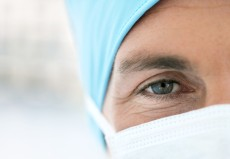What is Hirschsprung’s Disease?
- What is Hirschsprung’s disease?
- Does Hirschsprung’s disease cause constipation?
- What causes Hirschsprung’s disease?
- If I have more children, will they have HD too?
- What are the symptoms of Hirschsprung’s disease?
- How is HD diagnosed?
- How is HD treated?
- What can my child expect after surgery?
- Points to remember
What is Hirschsprung’s disease?
 Hirschsprung’s (HURSH-sprungz) disease, or HD, is a condition that affects the large intestine (colon) and causes problems with passing stool.
Hirschsprung’s (HURSH-sprungz) disease, or HD, is a condition that affects the large intestine (colon) and causes problems with passing stool.
HD usually occurs in children and is present at birth. HD results from missing nerve cells in the muscles of a portion of the baby’s colon. It causes constipation, which means that bowel movements are difficult. Some children with HD are not able to have bowel movements at all. The stool creates an obstruction in the bowel.
This requires early intervention to prevent stool from filling up the large intestine. Without treatment this can cause serious problems like infection, bursting of the colon, and even death.
Most parents feel frightened when they learn that their child has a serious disease.
Does Hirschsprung’s disease cause constipation?
Normally, muscles in the intestine push stool to the anus, where stool leaves the body. Special nerve cells in the intestine, called ganglion cells, make the muscles push. A person with HD does not have these nerve cells in the last part of the large intestine.
 |
 |
Healthy large intestine: Nerve cells are found throughout the intestine. HD large intestine: Nerve cells are missing from the last part of the intestine.
In a person with HD, the healthy muscles of the intestine push the stool until it reaches the part without the nerve cells. At this point, the stool stops moving. New stool then begins to stack up behind it.
Sometimes the ganglion cells are missing from the whole large intestine and even parts of the small intestine before it. When the diseased section reaches to or includes the small intestine, it is called long-segment disease. When the diseased section includes only part of the large intestine, it is called short-segment disease.
What causes HD?
HD develops before a child is born. Normally, nerve cells grow in the baby’s intestine soon after the baby begins to grow in the womb. These nerve cells grow down from the top of the intestine all the way to the anus. With HD, the nerve cells stop growing before they reach the end.
No one knows why the nerve cells stop growing. But we do know that it’s not the mother’s fault. HD isn’t caused by anything the mother did while she was pregnant.
Some children with HD have other health problems, such as Down’s syndrome and other rare disorders.
If I have more children, will they have HD too?
In some cases, HD is hereditary, which means mothers and fathers could pass it to their children. This can happen even if the parents don’t have HD. If you have one child with HD, you could have more children with the disease. Talk to your doctor about the risk.

What are the symptoms of Hirschsprung’s disease?
Symptoms of HD usually show up in very young children. But sometimes they don’t appear until the person is a teenager or an adult. The symptoms are a little different for different ages.
Symptoms in newborns
Newborns with HD don’t have their first bowel movement when they should. These babies may also throw up a green liquid called bile after eating and their abdomens may swell. Discomfort from gas or constipation might make them fussy. Sometimes, babies with HD develop infections in their intestines.

Symptoms in young children
Symptoms in young children Most children with HD have always had severe problems with constipation. Some also have more diarrhea than usual. Children with HD might also have anemia, a shortage of red blood cells, because blood is lost in the stool. Also, many babies with HD grow and develop more slowly than they should.
Symptoms in teenagers and adults
Like younger children, teenagers and adults with HD usually have had severe constipation all their lives. They might also have anemia.

Those with anemia look pale and tire easily.
How is Hirschsprung’s disease diagnosed?
To find out if a person has HD, the doctor will do one or more tests:
barium enema (BAR-ee-um EN-uh-muh) x ray
manometry (ma-NOM-eh-tree)
biopsy (BY-op-see)
Barium enema x ray
An x ray is a black-and-white picture of the inside of the body. The picture is taken with a special machine that uses a small amount of radiation. For a barium enema x ray, the doctor puts barium through the anus into the intestine before taking the picture. Barium is a liquid that makes the intestine show up better on the x ray.
In some cases, instead of barium another liquid, called Gastrografin, may be used. Gastrografin is also sometimes used in newborns to help remove a hard first stool. Gastrografin causes water to be pulled into the intestine, and the extra water softens the stool.
In places where the nerve cells are missing, the intestine looks too narrow. If a narrow large intestine shows on the x ray, the doctor knows HD might be the problem. More tests will help the doctor know for sure.
Other tests to diagnose HD are manometry and biopsy:
Manometry
The doctor inflates a small balloon inside the rectum. Normally, the anal muscle will relax. If it doesn’t, HD may be the problem. This test is most often done in older children and adults.
Biopsy
This is the most accurate test for HD. The doctor removes and looks at a tiny piece of the intestine under a microscope. If the nerve cells are missing, HD is the problem.
The doctor may do one or all of these tests. It depends on the child.
How is HD Treated?
Pull-through surgery
HD is treated with surgery. The surgery is called a pull-through operation. There are three common ways to do a pull-through, and they are called the Swenson, the Soave, and the Duhamel procedures. Each is done a little differently, but all involve taking out the part of the intestine that doesn’t work and connecting the healthy part that’s left to the anus. After pull-through surgery, the child has a working intestine.
 Before surgery: The diseased section is the part of the intestine Before surgery: The diseased section is the part of the intestinethat doesn’t work. |
 Step 1: The doctor removes the diseased section. Step 1: The doctor removes the diseased section. |
 Step 2: The healthy section is attached to the rectum or anus. Step 2: The healthy section is attached to the rectum or anus. |
Colostomy and Ileostomy
Often, the pull-through can be done right after the diagnosis. However, children who have been very sick may first need surgery called an ostomy. This surgery helps the child get healthy before having the pull-through. Some doctors do an ostomy in every child before doing the pull-through.
In an ostomy, the doctor takes out the diseased part of the intestine. Then the doctor cuts a small hole in the baby’s abdomen. The hole is called a stoma. The doctor connects the top part of the intestine to the stoma. Stool leaves the body through the stoma while the bottom part of the intestine heals. Stool goes into a bag attached to the skin around the stoma. You will need to empty this bag several times a day.
 Step 1: The doctor takes out most of the diseased part of the intestine. Step 1: The doctor takes out most of the diseased part of the intestine. |
 Step 2: The doctor attaches the healthy part of the intestine to Step 2: The doctor attaches the healthy part of the intestine tothe stoma (a hole in the abdomen). |
If the doctor removes the entire large intestine and connects the small intestine to the stoma, the surgery is called an ileostomy. If the doctor leaves part of the large intestine and connects that to the stoma, the surgery is called a colostomy.
Later, the doctor will do the pull-through. The doctor disconnects the intestine from the stoma and attaches it just above the anus. The stoma isn’t needed any more, so the doctor either sews it up during surgery or waits about 6 weeks to make sure that the pull-through worked.
What can my child expect after surgery?
Ostomy
Most babies are more comfortable after having an ostomy because they can pass gas more easily and aren’t constipated anymore.
Older children will be more comfortable, too, but they may have some trouble getting used to an ostomy. They will need to learn how to take care of the stoma and how to change the bag that collects stool. They may be worried about being different from their friends. Most children can lead a normal life after surgery.

Nurses at the hospital can teach you and your child how to care for a stoma and can talk to you about your worries.
Adjusting after pull-through
After a pull-through, 9 out of 10 children pass stool normally. Some children may have diarrhea for a while, and babies may develop a nay diaper rash. Eventually the stool will become more solid and the child will need to go to the bathroom less often. Toilet training may be delayed, as the child learns how to use the bottom muscles only after pull-through surgery. Older children might stain their underwear for a while after the surgery. It is not their fault. They can’t control this problem, but it improves with time. Some children become constipated because 1 in 10 children with HD has difficulty moving stool through the part of the colon without nerve cells. A mild laxative may also be helpful. Ask your doctor for suggestions.
 Drinking plenty of liquids is important after surgery for HD. Drinking plenty of liquids is important after surgery for HD. |
Diet and nutrition
One job of the large intestine is to collect the water and salts the body needs. Since your child’s intestine is shorter now, it absorbs less. Your child will need to drink more to make sure his body gets enough fluids.
An infant who has long-segment disease requiring an ileostomy may need special tube feedings. The shortened intestine does not allow the bloodstream enough time to absorb nutrients from food before it is pushed out of the body as stool. Tube feedings that deliver nutrients can make up for what is lost.
Eating high-fiber foods like cereal and bran muffins can help reduce constipation and diarrhea.
Infection
Infections can be very dangerous for a child with Hirschsprung’s disease. Infection of the large and small intestines is called enterocolitis (EN-tuh-ro-ko-LY-tis). It can happen before or after surgery to treat Hirschsprung’s disease. Here are some of the signs to look for:
fever
swollen abdomen
vomiting
diarrhea
bleeding from the rectum
sluggishness
Call your doctor tadalafil immediately if your child shows any of these signs. If the problem is enterocolitis, your child may be admitted to the hospital. In the hospital, an intravenous (I.V.) line may be needed to keep body fluids up and to deliver antibiotics to fight the infection. The large intestine will be rinsed regularly with a mild salt water solution until all remaining stool has been removed. The rinse may also contain antibiotics to kill bacteria.
When the child has recovered from the infection, the doctor may advise surgery. If the child has not had the pull-through surgery yet, the doctor may prepare for it by doing a colostomy or ileostomy before the child leaves the prednisone hospital. If the child has already had a pull-through operation, the doctor may correct the obstruction with surgery.
Enterocolitis can be life threatening, so watch for the signs and call your doctor immediately if they occur.
Long-segment HD
Sometimes HD affects most or all of the large intestine, plus some of the small intestine. Children with long-segment HD can be treated with pull-through surgery, but there is a risk of complications such as infection, diarrhea, and diaper rash afterward. Parents need to pay close attention to their child’s health. Also, since some, most, or all of the intestine
is removed, drinking a lot of fluid is important.
Points to remember
HD is a disease of the large intestine. HD develops in children before they are born. It is not caused by anything the mother did while pregnant.
Symptoms of HD include: delayed first bowel movement in newborns swollen abdomen and vomiting constipation since birth slow growth and development anemia.
Children with HD may get an infection, called enterocolitis, which can cause fever and diarrhea.
HD is a serious disease that needs to be treated right away. HD is treated with pull-through surgery or, sometimes, ostomy.
After treatment, most children with HD lead normal lives.




